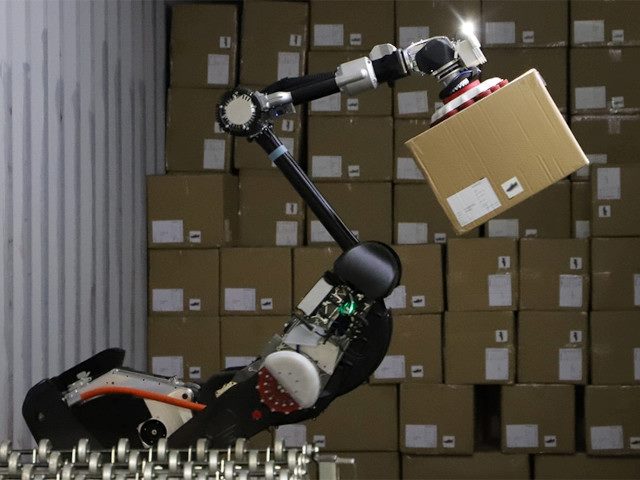While most of today’s robots are designed for repetitive processes that can be programmed once and run several times, the robotics industry continues to develop robots that use artificial intelligence (AI) to adapt to different conditions. AI-enabled robots are being designed to avoid obstacles, changes in the terrain and discern the size and shape of different objects. Here, we look at some of top AI products in the robotics industry:
1. Stretch
The AI-powered robot Stretch by Boston Dynamics is designed to facilitate warehouse operations by taking packages off trucks and loading them on conveyor belts. Stretch uses an advanced vision system that detects boxes and container surroundings. The robot is equipped with a purpose-built arm and gripper for strength, speed and reach. Stretch can work two full shifts on a single charge, operating effectively without the need to overhaul existing infrastructure. It is designed to maneuver in and out of trucks and tight spaces in a warehouse.
2. Gita
Manufacturer Piaggio Fast Forward offers two versions of its cargo-carrying gita robots built with smart following technology: gitamini and gitaplus. The mini is for smaller loads up to 20 pounds, and the plus is for larger loads up to 40 pounds. To activate follow mode, the owner stands in front of the robot and taps a pairing button. The robot then uses its vision to lock onto the owner and follow them. Each robot has a lid that closes, wheels, cameras, sensors and a lithium-ion battery.
3. RightPick
RightPick 4 is the latest-generation picking robot by RightHand Robotics that uses the company’s RightPick AI technology to continuously learn and improve on the overall range of items that can be successfully picked. The robot has multi-function smart grippers that combine sensing, suction and compliant fingers to accurately pick a variety of product shapes. It also has suction seal quality detection to enable autonomous piece picking for multiple markets, such as general merchandise, office supplies, apparel, pharmaceutical products, cosmetics and third-party logistics.
4. X30
The X30 is an industrial-grade robot dog by DEEP Robotics that uses AI to adapt to any number of unstructured and uneven surfaces, such as grass, gravel and rubble. X30 can traverse rugged terrains and navigate random objects. It is designed to withstand external interference, like pushing or pulling, and maintain its balance — an advantage in outdoor operations. Built to IP67 standards, the robot is able to function in challenging environments with huge variances in temperature, altitude or humidity.
5. MiR1200 Pallet Jack
With advanced AI-enabled pallet detection powered by NVIDIA Jetson AGX Orin, the MiR1200 Pallet Jack autonomous mobile robot (AMR) by MiR uses 3D vision to precisely identify, pick up and deliver pallets. Using real-time data from cameras and LiDAR sensors, the MiR1200 dynamically modifies its route to avoid obstacles, such as loose objects on the floor and overhead obstructions. Its ability to navigate in tight spaces with minimal changes to the existing infrastructure makes it ideal for optimizing logistics efficiency with timely pallet delivery.
6. TM5-700
The TM5-700 by Techman Robot is a compact collaborative robot (cobot) designed to be integrated into a production line. The cobot includes a built-in vision system and AI specifically for flexible production needs required by small parts assembly and production processes in consumer electronics and consumer goods. It has a maximum reach of just under 2 feet and a maximum payload of just over 13 pounds. Other Techman cobots aren’t as compact, but they offer larger payload capacities.
7. Phoenix
The Phoenix 7 by Sanctuary AI is a general-purpose humanoid robot designed to assist humans in laborious or repetitive tasks that uses the company’s AI control system. Sanctuary AI expects its AI to evolve more under its collaboration with Microsoft, which the companies announced this year. The Phoenix 7 was launched this spring, a little more than a year after the Phoenix 6 was released. The latest generation features improved dexterity, range of motion and speed over its predecessor.
8. RecycleOS
The enterprise robot RecycleOS by EverestLabs uses AI algorithms and sensors to identify recyclable materials based on shape, color and texture, significantly improving sorting accuracy and efficiency. The sorter has mechanical arms that pick items from a conveyor belt and sort them into different chutes based on the information provided by the AI and computer vision systems. The robot can increase material recovery rates by up to 40% and cut labor and disposal costs by 40 to 60%, according to the company.
9. Digit
Agility Robotics’ Mobile Manipulation Robot (MMR) uses large language model (LLM) technology to navigate in different environments. The robot includes legs, arms and vision capability to be able to walk into existing facilities and address the hardest-to-automate portions of the workflow in manufacturing, warehouse and distribution facilities. The 5-foot, 9-inch robot can reach from the floor to 5.5 feet and has a carrying capacity of 35 pounds, enabling it to perform a wide variety of tote movement operations.
10. Adam
The two-armed robot Adam by Richtech Robotics is designed to work as a bartender, barista or chef, depending on a customer’s needs. Adam features six joints for flexibility and custom grips for various tasks. The robot is designed to provide consistent portions, with AI enabling it to mix different types of drinks and with the speed to make up to 60 drinks per hour. Richtech is planning to add speech capabilities, so the robot can carry on casual conversations.
